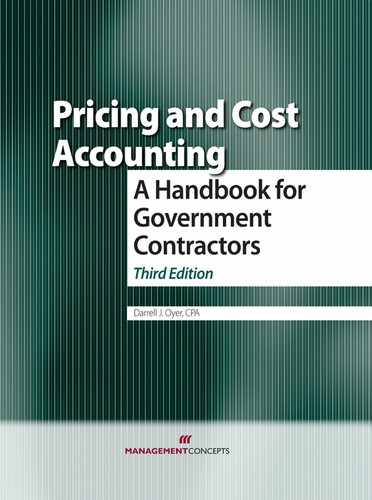Preface
Government contracting is unique. Its intricacies often cannot be understood using common sense and experience in the commercial marketplace. The terminology alone is confusing to the uninitiated. However, the rules are not mysterious—they simply need to be understood. The purpose of this book is to help demystify the process of winning and carrying out a government contract.
Obtaining government business is often very different from obtaining commercial business, largely because extensive rules are in place to ensure fairness in the award of contracts that use public funds. Contractual arrangements with the government feature documents that contain numerous contract clauses, all of which need to be read and understood—even in the haste of preparing a contract bid. The nature of determining contract price is often significantly different because of the various alternatives to the firm-fixed-price arrangement most common in the commercial marketplace.
Not only is the government your customer, but it also acts as your overseer in some contract situations. Accordingly, both estimating and accounting systems may have to be audited before you can successfully obtain and conclude a government contract. A key issue is that not all costs can be included in your price to the government. Detailed rules on reimbursement are designed to prevent the taxpayer from paying for costs that are “against public policy.”
Current and potential contractors must be aware of and understand the rules. Most contractors are at least familiar with the Federal Acquisition Regulation (FAR); importantly, however, rules and regulations related to the cost accounting standards (CAS) may also be applicable to a contract.
Government contracting rules and regulations are constantly changing. Contractors need to be current on the often-changing requirements.
Since 1999 the thresholds for certification of cost and pricing data have changed twice, the threshold for CAS coverage has been substantially revised, new issues have arisen in commercial item contracting, profit guidelines have been revised by several major agencies, cost principles have been revised, and audit initiatives have been redirected. This third edition incorporates these changes and many others.
Without current information you could be attempting to comply with rules and regulations that are no longer current. Or, you could be in noncompliance with unknown new rules. The former is costly and the latter can be fatal to a business entity.
This book is intended to serve as a practical guide for contracting with the federal government. To help guide current and potential contractors in dealing with the myriad issues that can arise from contract bid through contract closeout, the book follows the life cycle of a government contract.
Chapter 1 describes the methods that the government uses to award contracts. The focus of the remainder of the book is on those situations where government involvement in contractor operations is most significant. Chapter 2 describes the various types of government contracts, generally falling under the categories of fixed-price and cost-reimbursement. The pricing and administration of the various contract types are often closely related to their unique features.
Chapter 3 addresses what a contractor must include in an accounting system that will be considered adequate for government contracting. Key requirements are written policies and procedures, labor recording practices, designation of direct vs. indirect costs, establishment of indirect cost pools, establishment of cost controls, and consistency in application. Contractors should establish an accounting system before pricing or bidding on a contract.
Not all business costs are allowable in pricing and billing costs under many government contracts. A cost must generally be reasonable in nature and amount, allocable to the contract, in accord with generally accepted accounting principles and practices, and in compliance with the contract terms. Chapter 4 addresses these aspects of pricing and billing. In addition, Chapter 5 addresses individual cost allowability rules contained in the FAR.
Some contracts and subcontracts are subject to the CAS. Chapter 6 addresses which contracts are covered by the CAS, who must submit a CAS disclosure statement, the difference between full and modified coverage, the ramifications of the CAS contract clause, the dreaded cost impact statement, and the key aspects of the 19 standards.
With an understanding of the contract types and the cost rules described in the preceding chapters, a contractor can turn to estimating costs or developing prices as described in Chapter 7. Generally, a contractor should have established estimating policies and procedures, and provide for estimating techniques by cost element. Chapter 8 contains advice on the second element of a price: markup on cost or estimated cost. The FAR and individual agencies have their own rules on how markup is to be evaluated; these guidelines are described.
Chapter 9 addresses a unique aspect of government contracts when prices are negotiated based on cost and pricing data: the Truth in Negotiations Act. The basics provisions of this act—specifically, defective pricing and postaward reviews—are described in detail. The chapter addresses penalties, reasons for the law, basic requirements, covered pricing actions, government proofs of defective pricing, and contract price adjustments.
Chapter 10 covers matters related to contract administration. These include contract modifications, subcontracting responsibilities, cost monitoring and reporting, and contract closeout. In addition, the government may terminate a contract for convenience. Cost-reimbursement rules for these terminations are described.
The final chapter, Chapter 11, addresses the various audits that may be performed during contract performance. These audits include price proposals, incurred costs, contract modification pricing, postaward reviews, termination settlements, interim payment requests, the CAS, accounting systems, estimating systems, operations audits, financial jeopardy audits, and contract closeouts.
Contracting with the federal government can be a worthwhile, profitable undertaking. The key is to understand the applicable rules and regulations—and to be prepared to carry them out in a way that enables the contracting relationship to be mutually beneficial for both the contractor and the federal government. It can be done!
Darrell J. Oyer, CPA
February 2011
Instructor materials available. Please contact [email protected].
